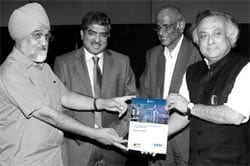Technology: Enabling the transformation of power distribution

Digital technology can serve as a catalyst to transform the power sector in India, according to a report commissioned by the Ministry of Power, Government of India. The report prepared by the Center for Study of Science, Technology and Policy (CSTEP), and Infosys proposes a road map to improve the condition of power distribution in India, which is currently riddled with losses.
The report, overseen by former Infosys co-chairman Nandan Nilekani, discusses the challenges of the power sector, the confluence of technology, policy and regulation; the interface between various stakeholders, the role of information technology as a catalyst, and consumers as change agents.
Key takeaways of the report:- While digital technology provides a framework for an efficient system through the technical design of a smart grid, it cannot impact supply and demand, tariff structure, and power quality.
- Utility companies can effect a business transformation by adopting technologies such as Geographical Information System (GIS), Customer Information System (CIS), Advanced Metering Infrastructure (AMI), Maintenance and Material Management System, and Network Management System.
- New models of consumer participation must be explored as the consumer is at the center of this transformation.
- Open architecture can effect a transformation in the power sector and insulate it from evolution in technology.
- Distribution companies must take a holistic and top-down approach; while creating a business strategy to drive the technology roadmap.
- This transformation can be catalyzed by setting up a national institution that will work along with stakeholders from across the industry, to implement these plans in an accountable and methodical manner.
More information:
Download the 2002 IT Task Force Report

